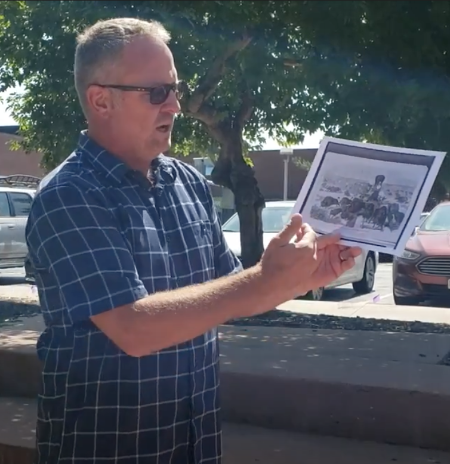Analyzing Primary Sources: Caption Writer
The Caption Writer strategy comes from Dr. Roland K. Schendel, undergraduate/graduate professor of education at Metropolitan State University of Denver.
Children experience much of their world by viewing pictorial and illustrated representations of it. Such visuals allow children to learn about the world around them. They translate ideas through viewing. In order to accurately translate images, children must be taught how to view them. They must be taught strategies for making sense of what they think they see, based on background knowledge and experience, and what an image really means. Therefore, linking illustrated text to written text can enhance a child’s understanding of images.
Caption Writer is one way for students to learn how to accurately interpret visual images like pictures and illustrations in texts. Students first view a descriptive historical photo, illustration, or map. Then they might read supporting literature that explains the image or discuss the image with a peer. Students then evaluate and synthesize the information to create an accurate caption describing the image.Teaching Suggestions
- Collect a wide variety of powerful/unusual images and illustrations or have the students do so. Scaffold student support by providing pictures with captions included, pictures embedded within the written texts that they are a part of with no clear captions, and pictures alone. For images that do not include text, be sure that supporting texts are available for students to locate information that will help them interpret the image.
- State the purpose of Caption Writer. Viewing images can be very informative but viewing often requires the support of written text or video to accurately interpret an image’s true meaning. This activity links visual information with written information to enhance the understanding of the viewer and reader.
- Distribute one image that includes a caption to each student.
- Invite students to study their images and think about what the image is about. After a few minutes, invite students to turn-talk-and listen to a neighbor as they explain their images. Circulate the room to listen in on student conversations. If individuals have not read the captions to assist them, instruct them to do so.
- Tell students that the caption is a brief explanation of an image. Inform them that they will use their viewing and reading skills to create a caption for an interesting image.
- Distribute one image without a caption to each student. Provide supporting literature with the image.
- Instruct students to view the image to figure out its meaning.
- Encourage students to read the supporting literature to gain understanding of the image. Circulate the room to make sure that the supporting texts can be read independently by individual striving readers, monitor understanding of the activity and what is read, offer an alternative image if necessary, and to provide instructional support as necessary.
- Invite students to create a brief, descriptive caption that accurately defines their image.
- Instruct students to display their captions around the room or pass them to peers to explore the thinking of others.
In this video, Dr. Schendel explains how educators might use the Caption Writer strategy as a pre-assessment, formative assessment, and summative assessment.
A related strategy, Caption This!, comes from TPS Consortium member Glenn Wiebe, an ESSDACK education specialist and author of the History Tech blog.

